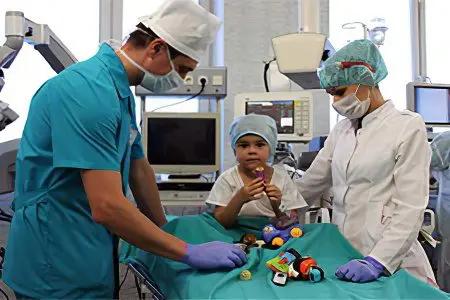Contents

Immediately after birth, the baby’s nasal septum is straight and even. It is represented by cartilaginous tissue, but with small areas of ossification. As the child grows older, the bone tissue becomes more and more. These islands begin to coalesce with each other. The septum can be bent for certain pathological reasons that occur in the human body during his life.
In children, the septum in the nose is curved less frequently than in adults. However, such a pathology occurs. If this happens, then the child’s breathing suffers, which negatively affects the body as a whole. The brain and organ tissues begin to experience oxygen starvation. In childhood, this causes a delay in mental and physical development. Even the appearance of the child changes. His mouth is always ajar, his skin is pale, his constitution is asthenic. The reasons for such changes lie in anemia and tissue hypoxia.
Causes of deviated septum in children
Causes of deviated septum in children include:
Received injury. Injury to the cartilage and bones of the nasal septum can occur during childbirth or throughout life.
Launch of compensatory mechanisms. They are activated in children suffering from frequent respiratory diseases, adenoids, nasal polyps, chronic rhinitis.
Violation of the growth rate of cartilage and bones of the nose.
Symptoms of deviated septum in children

The following symptoms of a deviated septum in children can be distinguished:
Violation of nasal breathing. It arises from the side of that nostril, which is blocked by a deformed plate. Parents may note that sometimes the child has a completely blocked nostril, while the other is breathing freely. Sometimes children roll over on one side during sleep to facilitate nasal breathing.
Prolonged chronic rhinitis with complications. Their occurrence is explained by the fact that the mucous membranes become vulnerable to attacks by infectious agents. They become denser and thicker, polyps can form in the nose. These outgrowths further aggravate the situation.
Frequent nosebleeds. Injury to the mucous membranes occurs due to the fact that they do not receive sufficient moisture.
Otitis. When the Eustachian tube is blocked, it cannot be ventilated and cleared properly. Therefore, the middle part of the ear often becomes inflamed.
Persistent colds: angina, SARS, laryngitis. Normal nasal breathing is impossible, the child breathes through the mouth all the time. It is not difficult for bacteria and viruses to enter the respiratory tract of a child and begin to multiply there.
Snore. In a dream, the child will make the appropriate sounds. They occur due to the presence of an obstruction in the path of air.
Proliferation of the adenoids. The more often a child gets sick, the more his adenoid tissues grow.
Headache. They arise due to oxygen starvation of the brain.
Deterioration of smell. The receptors that are located in the nasal mucosa gradually die off.
Sometimes, during an external examination of a child, it is impossible to notice any changes in his appearance. His nose looks straight. However, when examining the nasal cavity, the doctor detects a narrowing of the nasal passages. Therefore, the air in one nostril does not circulate normally. The mucous membranes swell, their defenses are reduced. As a result of such a violation, the child often suffers from a runny nose and inflammation of the ears.
Diagnostics
The doctor makes a diagnosis on the basis of an external examination of the patient and after a series of studies. During an endoscopy, the doctor examines the inside of the nose, the back of the septum.
If a doctor cannot visualize a deviated septum, but suspects a deviated septum, they will refer the patient for an X-ray, CT scan, or MRI.
Treatment of deviated septum in children

For children under 14 years of age, surgery to correct the nasal septum is performed only in emergency cases. At this age, mainly conservative methods of treatment are used. It is aimed at eliminating the symptoms of the disorder, normalizing nasal breathing and removing edema from the mucous membranes of the nose (cromones and sprays with a mucolytic effect, vasoconstrictor drugs, moisturizing sprays).
If it was not possible to achieve improvement with the help of medicines, then the child is shown an operation. Septoplasty in childhood is performed only if there are strict indications and after reaching 14 years.
Surgery

They try to protect young children from surgery to correct the nasal septum. This procedure may adversely affect its further formation. Therefore, the help of a surgeon is resorted to only in emergency cases.
The procedure to correct the nasal septum is called septoplasty. It is prescribed for children over 16 years of age. Less commonly, it can be performed on children over 6 years of age.
The type of anesthesia depends on the age of the child and the characteristics of the surgical intervention. Children under 5 years of age are given general anesthesia. For schoolchildren, the procedure can be performed under local anesthesia.
During the operation, the doctor makes an incision inside the nose, after which it separates the mucous membrane from the cartilaginous tissues. The doctor corrects the cartilage itself, the spikes, ridges are removed, the correct shape of the nose is formed. The cartilage is set in the desired position, the wound is sutured.
If the cartilage is too thin and cannot support the shape of the nose, then its fragments are attached to a special mesh. If this is not done, then there is a possibility of nose sagging or other deformities. The grid will not be felt by the child. In a year, it will completely dissolve. In this case, the cartilage will already be able to independently maintain the shape of the nose.
In the first week (10 days) after the operation, the child should have as little contact with other people as possible. This will prevent infection with infectious diseases and prevent the development of complications of the disease.
Laser treatment
Treatment of a deviated nasal septum with a laser is an innovative technique that allows you to prevent tissue injury and minimize any side effects. Recovery after surgery is fast.
Cartilage cauterization with a laser up to 70 °C contributes to the burning of its structures, due to which it is possible to correct the shape of the nose. The operation is bloodless, as the vessels instantly coagulate. Special tampons are introduced into the nasal passages, which allow you to give the septum the correct shape.









